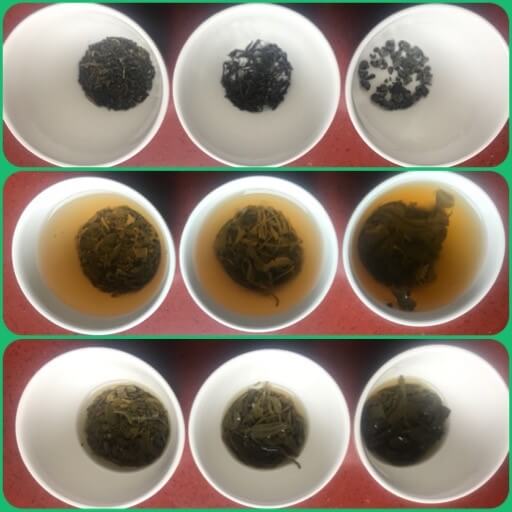
Green tea and black tea (and the more rare white tea) all come from the Camellia sinensis plant. Green tea is the oldest type of tea, records go back to China around 3000BC. It is less processed then all other (Camellia) teas. High anti-oxidant and several other health advantages are contributed to green tea.The leaf color is green to very dark green/blackish, the tea itself can be light green to golden. Green teas are often recognizable by the shape of their leaves. Contrary to black teas - the tea leaves are whole, not broken up into smaller pieces. This is one of the reason you want to buy loose teas. Green tea bagged into an individual 1 cup teabag exists of broken leaves and will loose some of its taste and its anti-oxidant capacity. Another reason is, it is fun to brew as often the tea leaves change shape while they unroll during the brewing process. Green tea is created by picking the leaves and drying them. The drying process differs per region or country (that is one reason it is important to know where your tea is coming from). As part of the drying process the tea sometimes is shaped to be flat, or rolled up like the gunpowder tea. Matcha tea is a green tea where the leaves are powdered after drying and the stems and veins have been taking out. Check out our black and green teas.
The brewed green tea can be greenish or golden / brown and mostly looks very similar to brewed black tea. The taste is distinctively different from black tea and generally the aroma is lighter. The tastes of green teas we offer vary between a light floral to a pronounced strong taste. The location where the teas grows is an important determinant for tastes of green tea. A second determinant is the timing of picking of leaves: early while the leaves are just popping out of their buds, or later in full growth at the end of the growing season. Last but not least, the drying method is extremely important in taste definition. And when you brew your tea you yourself can determine to make it strong, or less strong by the amount of water you add.
Black teas were created for export to Europe in the 17th century. Originally Europeans brought green teas from India and China, the dominant teas available at that time. Soon they discovered that the unprocessed teas became moldy in their countries (mainly England and Holland) due to the unfamiliar high humidity. The solution was to oxidize the leaves before transport. Sometimes this is called fermenting. Oxidation extends the life time of the teas and creates a different taste. Different regions and countries developed different methods contributing to the even wider variety in black teas then in green teas. The traditional method of oxidation starts with spreading the leaves out in the sun to lower their water content. The leaves are then rolled or pressed to break the cells and are further oxidized using methods that are specific for each region. Just as with green teas, the location and the timing of picking adds to the large variety in black teas.
Most black teas have a stronger aroma than green teas. The taste can be light and floral to strong, dark, earthly and grounding. If you choose your first black teas it is probably better to start with a lighter one. If you choose to replace coffee with tea it is possibly the best to start with a stronger black tea.
ADVICE: if you are new to tea, or if you want to become more of an expert, buy 3 or 4 different loose teas, before brewing smell them, check out the shape of the leaves, and be aware of the color. Then brew each tea at the same time, following their directions for amount needed and brewing time and smell again, compare color and taste and check how the leaves changed with the brewing. (Best to use all glass or white inside cups). Make notes to remember for next time!

Be the first to comment